“Advertising today is selling Corn Flakes to people who are eating Cheerios” (Levinson, 1994) In one simple sentence, advertising icon Leo Burnett is able to provide insight into the complex and constantly-evolving world of advertising. While you may not recognize Burnett by name, there is no doubt that you will know his work as he is responsible for bringing some of the most recognized brands to life; including: the Pillsbury Doughboy, the Keebler Elves, the Marlboro Man, the Jolly Green Giant, Tony the Tiger and Ronald McDonald. What made Leo Burnett so successful was the innovative use of textual, audible and visual elements to capture the imagination and the emotions of the target demographic. It is these elements combined with the emergence of communication technologies that have allowed advertising to evolve into an entity that blends information, innovation and science to be the educator of new technology.
The History of Advertising
While we will examine the psychology of advertising in the digital age, it is important to consider the evolution of advertising and more specifically the inventions that helped shape its foundation. The printing press, the radio, the television and most recently the Internet are all types of media that are used to inform, educate, persuade, and communicate (Sample, 2007).
It was these activities that are found at the dawn of the advertising era. In pre-literate cultures, street callers would announce the arrival of ships, cargo and where proprietors would be able to set up tables to sell their fruits and vegetables (Reference.com, 2010). The signs on the street would be crafted in the shape of whatever was being sold in the shops, a boot for shoes, a diamond for jewellery or a bag of flour for baking goods (Reference.com, 2010). In Pompeii, examples of advertising on shop signs for establishments for drinking and eating and accommodations were mostly simplistic in nature but there are also examples of “beautiful illustrations and persuasive words” (Rokicki, 1987). The walls of Pompeii were blanketed with messages in what could be considered as the earliest example of billboard advertising (Sampson, 1875). The campaign slogans for politicians would also be displayed (Reference.com, 2010). All of these inscriptions were written in Latin, and were divided by scholars into three categories: formal inscriptions, graffiti, and dipinti. The first and most formal was also the most long-lasting as stone was the standard canvas. It would be used for communicating charitable acts or to praise or immortalize public works projects. The second, graffitti, which literally translates to “scratches”, used more simplistic engraving techniques and was very popular in Pompeii. The last category, dipitni, were wall paintings that were used to promote elections, or to inform the public about upcoming games (Rokicki, 1987).
In Egypt, papyrus was used as the standard media for posters and notices while commercial entities tended to use painted walls or stones. The painting of walls or stones actually originated in 4000 BCE with the Indians and their rock-art paintings. This is a great example of the evolution of advertising media across completely different cultures (Reference.com, 2010).
The development of the printing press brought an abundance of change from influencing politics and family life to striving to achieve universal literacy (Ong, 115-116). The printing trade also went through a significant transformation as scribes who once wrote books, weekly newspapers and advices by hand were no longer needed. Those who specialized in decoration, illumination or painting continued to find employment for some time as such treatment continued to be applied to some printed books well into the next century (Clement, 1997). It was near the end of the 1400s where half-title pages started appearing in books listing the book title and the name of the author. This not only advertised the topic of the book, but it also acted as a promotional tool for the author and eventually evolved into the title page that is commonly found in books today. This is another example of the evolution of advertising media as the ancient art of printing helped revolutionize how books, and other types of printed media were formatted (Clement, 1997).
Using the aforementioned textual elements, the first ad for coffee was published as strictly text with no visual elements. It appeared on May 26th, 1657 in the Publick Advisor:
In Bartholomew Lane, on the back side of the Old Exchange the drink called coffee, which is a very wholesome and physical drink, have many excellent vertues, closes the orifices of the stomach, fortifies the heat within, helpeth digestion, quickeneth the spirits, maketh the heart lightsum, is good against eye-sores, coughs, or colds, rhumes, consumptions, head ache, dropsie, gout, scurvy, King’s evil, and many others; is to be sold both in the morning and at three of the clock in the afternoon. (Wood, 1958, p.32)
While it is impossible to know if the author of the advertisement actually believed that coffee was the miracle cure it is made out to be, it is interesting to see that while the media used for advertising has evolved, the techniques used by advertisers hasn’t really changed.
To call attention to important advertisements, in March of 1681 the Domestic Intelligencer used a pointing finger ornament:
WHEREAS a Person in London on some discontent did early on Monday morning last retire from his dwelling-house and not yet return’d, it is the earnest request of several of his particular friends, that the said person would speedily repair to some or one of them, that he thinks most fit, it being of absolute necessity for reasons he does not vet know of. (Wood, 1958, p.35)
Eventually, black and white and coloured images became commonplace alongside written text in newspaper articles.
The invention of the radio in the 1920s marked the first time oral narrations and storytelling was able to reach families directly in their home. Advertising was able to connect the human voice and the emotional appeal of drama to the products or services that they were trying to sell. This 26-second Old Spice commercial is a great example of this technique:
Audio clip: Adobe Flash Player (version 9 or above) is required to play this audio clip. Download the latest version here. You also need to have JavaScript enabled in your browser.
The introduction of the radio galvanized the advertising world, adding a new dimension to the creative process (Wood, 1958). The invention of the television brought commercial advertising to an entirely new level, as radio programming and commercials transformed with the addition of a visual element. It quickly became the preferred media choice for advertisers (Wood, 1958) until the creation of the World Wide Web in 1990 by Tim Berners-Lee and Robert Cailliau. The vision that Berners-Lee had for what would eventually become the Internet was humble in comparison to the commercial entity that it has become today. An intricate balance of words, sounds and images blended together in a wide array of techniques used by advertisers to attempt to catch the attention of the masses (Bolter, 68-69). The complexity of advertising is such that it is recognized as a science, in particular the psychology behind successful advertising campaigns.
The Psychology of Advertising
It is almost impossible to watch television or browse the Internet without at least one commercial advertisement appearing on the screen. With television, the advertisements are usually easy to recognize. Product placement for instance is where commercial products are visible, like the Coca Cola bottles on American Idol or something more elaborate like a scene being scripted to have an actor talk about a specific feature of a product like a car or a smartphone. The latter has become more popular since the invention of the digital video recorder since people now have the ability to record live television and skip commercials.
The latest advertising techniques and methodologies are based on statistics, complex algorithms, browsing and watching habits, geo-specific interests, and a wide range of other variables. They have also become a showcase for the latest technologies for displaying dynamic text, sounds and images which advertisers use to promote their product. While the quality of the product is still important, it is how the product is advertised that will determine its success or failure.
Among the most successful advertisers is Apple. This is an interesting statement considering they are a technology company, but Apple is recognized equally for the aesthetics of their technology and for their multi-million dollar ad campaigns starting with the release of what is regarded as “The Greatest Commercial of All Time” in 1984.

This started a trend of groundbreaking advertisements by Apple, that blended oral and literal elements that truly captivated the viewing audience. The most successful of these ads are the iPod ads:

In the Internet era, it is websites like Facebook.com and YouTube.com that are among the most popular for advertisers. In fact, their entire business is based on income generated by advertising dollars. The technologies used for advertisements have become so advanced that they are able to display ads that are specifically generated to be of interest to the individual who is browsing the page. Google.com is another excellent example, their cloud-based email client Gmail has text-based advertisements that appear above your inbox. The advertisements that appear are generated based on keywords that are in the email messages that you have received.
The psychology of advertising has evolved to the point that advertisers are using multiple forms of advertising media and the best elements of each to reach the widest possible audience. The following videos show how Old Spice has evolved their message from the radio advertisement that you listened to earlier to a television advertisement and a collection of videos on YouTube.com, each specifically addressed to one person.
Conclusion
In commenting on our culture being dominated by imagery, Frederic Jameson commented that “My sense is that this is essentially a visual culture, wired for sound—but one where the linguistic element … is slack and flabby, and not to be made interesting without ingenuity, daring and keen motivation” (As sited in Bolter, 47-48, 2009). While there has certainly been a shift away from print technology, it is clear from the blending of textual and visual elements in advertising that literacy is still an integral aspect of modern culture. The creativity, actuation and risk-taking involved in commercial marketing are not only helping promote products but they are ensuring that linguistics stay relevant.
An excellent example of the blending of textual and visual elements is in the following short film. While it isn’t directly related to advertising it supports the statement above.

References
Apple(producer). (2006, April 4). Apple 1984 macintosh commercial [commercial]. Retrieved from: https://www.youtube.com/watch?v=G9S8JS1qyRM.
Apple(producer). (2006, July 25). iPod ad technologic – daft punk [commercial]. Retrieved from: https://www.youtube.com/watch?v=G9S8JS1qyRM.
Bolter, Jay David. (2001). Writing Space: Computers, Hypertext, and the remediation of print. Mahwah, New Jersey: Lawrence Erlbaum Associates.
Clement, R. W. (1997). Medieval and renaissance book production: the printed book. In R. Clement (Ed.),books and universities. Retrieved from: http://www.the-orb.net/encyclop/culture/books/medbook2.html.
Hughes, P. (Director). (2009, January 29). SIGNS [Video]. Retrieved from: https://www.youtube.com/watch?v=uy0HNWto0UY&fmt=18.
ICTeachers Ltd. (2007). ICTeachers photo library ancient civilisations. Retrieved from: http://www.icteachers.co.uk/photos/ancientcivilisations.htm.
Levinson, J. C. (1994). Guerilla advertising: cost-effective techniques for small-business success. New York: Houghton Mifflin Company.
Ong, W. (1982.) Orality and literacy: the technologizing of the word. London: Methuen.
OldTimeRadioFans.com. Listen to retro old radio commercials: old spice. Retrieved from: http://www.oldtimeradiofans.com/old_radio_commercials/old_spice.php.
Old Spice(producer). (2010, February 5). Old Spice: the man your man could smell like [commercial]. Retrieved from: http://www.oldspice.com/videos/all/22/the-man-your-man-could-smell-like/.
Old Spice(producer). (2010, July 12). Old Spice: Re: @TheEllenShow [YouTube Video]. Retrieved from: https://www.youtube.com/watch?v=0Cs95FmimP0.
Reference.com (2010). Advertising. Retrieved from http://www.reference.com/browse/Advertising.
Rokicki, J. (1987). The CBS interactive business network: reference publications: advertising in the Roman Empire. Retrieved from http://findarticles.com/p/articles/mi_m1510/is_1987_Spring/ai_4806053/pg_5/?tag=content;col1.
Sample, T. (2007). Ezine articles: The history and evolution of the advertising industry. Retrieved from http://ezinearticles.com/?The-History-and-Evolution-of-the-Advertising-Industry&id=457430.
Sampson, H. (1874). A history of advertising, from the earliest times: illustrated by anecdotes, curious specimens, and biographical notes. Chatto.
Wood, J. P. (1958). The story of advertising. New York: Ronald Press Co.

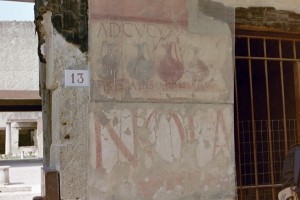




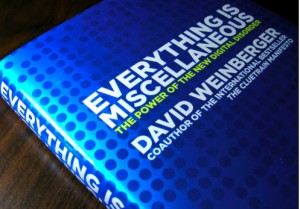




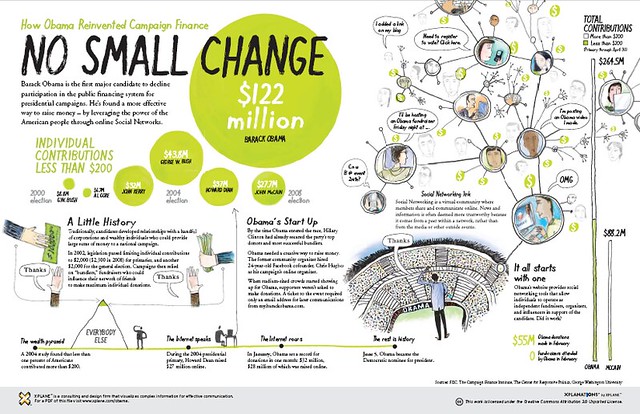




Web 2.0 storytelling: Physics Teachers and Rabbit Holes
Schools have been slow to adopt widely popular forms of communication and expression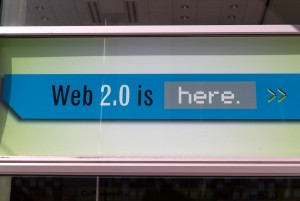 (Bolter, 2001). A predominant form is Web 2.0, which “refers to the social use of the Web which allow people to collaborate, to get actively involved in creating content, to generate knowledge and to share information online” (Grosseck, 2009, p.478). Web 2.0 is distinct because it joins microcontent with social media (Alexander & Levine, 2008). It depends upon openness, an ‘ethos of sharing,’ and the wisdom of its users (Alexander, 2006). A key to its rapid growth is a long list of social software, such as Blogpost, Twitter, Facebook, Flickr, Feedly, Wikipedia, and Delicious. The simplicity of these tools has meant that people are increasingly connecting, discussing, and meeting with others, as well as contributing, editing, and reading content more frequently. Another large influence on Web 2.0 has been the evolution of the cell phone, which now provides instant access to free web based software and online storage, contains a digital camera, and is ideally suited for microcontent.
(Bolter, 2001). A predominant form is Web 2.0, which “refers to the social use of the Web which allow people to collaborate, to get actively involved in creating content, to generate knowledge and to share information online” (Grosseck, 2009, p.478). Web 2.0 is distinct because it joins microcontent with social media (Alexander & Levine, 2008). It depends upon openness, an ‘ethos of sharing,’ and the wisdom of its users (Alexander, 2006). A key to its rapid growth is a long list of social software, such as Blogpost, Twitter, Facebook, Flickr, Feedly, Wikipedia, and Delicious. The simplicity of these tools has meant that people are increasingly connecting, discussing, and meeting with others, as well as contributing, editing, and reading content more frequently. Another large influence on Web 2.0 has been the evolution of the cell phone, which now provides instant access to free web based software and online storage, contains a digital camera, and is ideally suited for microcontent.
Story writing is also being transformed, with redesigns and remixes appearing as movies, podcasts, animations, and collages. One of the biggest impacts of Web 2.0 on writing has been from wikis, where stories can compiled asynchronously by a variety of authors. We may also be getting a glimpse into the future with the emergence of a highly developed method of Web 2.0 storytelling known as Alternate Reality Gaming (Alexander & Levine, 2008).
There are many obvious advantages to incorporating Web 2.0 into the classroom, such as increased flexibility, resources, sharing and independence (Grosseck, 2009). For example, student storytelling can go from a solitary and linear procedure to a collaborative process that produces multilinear stories. Web 2.0 tools (wikis, Google Docs, etc. . .) allow for greater collaboration through asynchronous writing, editing, and discussions, and enable students to produce a superior quality of work. The adoption of Web 2.0 in the classroom will help teachers “foster collaborative work not only among their own students, but with colleagues, students, and community members from around the world” (Grosseck, 2009, p.482).
For all its benefits, there are several issues that teachers must be aware of regarding Web 2.0 in education. Educators need to discern what is suitable for students from the overwhelming amount of existing technology (Grosseck, 2009), and be mindful that the medium is not neutral. Teachers need to learn how to implement Web 2.0 in ways that improve learning, rather than contribute to the decay of scientific thought and “the erosion of creativity” (Grosseck, 2009, p.481). They need to be prepared for the possibility that software and media can disappear without notice (Levine, 2007, p.2), and the reality that new approaches to assessment need to be taken.
Students should be taught how to properly navigate and communicate in Web 2.0. One reason is that the line between real and fiction can become blurred with Web 2.0 storytelling. As a result, students need to learn about how to verify, borrow from, and cite sources. The ease with which content can be used, mixed, and shared makes it “easier for average citizens to commit copyright violations” (Alexander, 2006, p.42). The most important consideration is that teachers should be able to protect students and their privacy. Students need an environment where they feel safe and are able to express opinions and make mistakes without having them archived. Therefore, there are times when using a closed environment will be the most appropriate medium for a class.
With these issues in mind, my goal is to integrate Web 2.0 into my high school Physics classroom as a way to further engage my students, as well as provide them with new meaningful ways to learn. Some examples of Web 2.0 storytelling that would apply to my classroom are creating stories of the atom with Animoto, recounting the life of a scientist with a wiki, writing journal blogs, and sharing photos of Physics principles through Flickr. I also plan to use social bookmarks to enrich the curriculum as well as blogs and microblogs to encourage discussion and relay content in a more conversational manner.
Although it is difficult to predict how education will evolve, it appears that Web 2.0 will play in important role (Alexander & Levine, 2008). Rather than ignore the involvement of our students in social mediums, Alexander and Levin encourage educators to give new forms such as “Web 2.0 storytelling a try and see what happens” (Alexander & Levine, 2008, p.56). This will not come without its challenges, however, the payoffs will hopefully be that students become more engaged, find the content more relevant, learn new skills, and access higher order thinking. Introducing Web 2.0 into my classroom requires a leap of faith, but the time has come for me to jump down the rabbit hole and embrace the trip.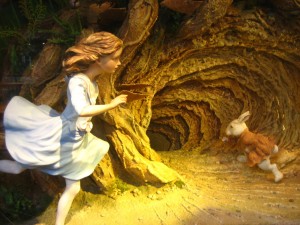
References
Alexander, B. (2006) “Web 2.0: A new wave of innovation for teaching and learning?” Educause Review, 41(2), 34-44. Retrieved, April 5, 2008, from http://www.educause.edu/ir/library/pdf/ERM0621.pdf
Alexander, B., & Levine, A. (2008). Web 2.0 story-telling: The emergence of a new genre. Educause Review. 43(6), 40-56. Retrieved, August 10, 2009, from http://net.educause.edu/ir/library/pdf/ERM0865.pdf
Bolter, Jay David. (2001). Writing space: Computers, hypertext, and the remediation of print [2nd edition]. Mahwah, NJ: Lawrence Erlbaum.
Grosseck, G. (2009). To use or not to use web 2.0 in higher education? Procedia – Social and Behavioral Sciences, 1(1), pp.478-482. Retrieved from http://webpages.csus.edu/…/to%20use%20or%20not%20to%20use.pdf
Levine, A. (2007). It’s the craft, not the tools: 50 web 2.0 ways to tell a story. Retrieved from http://www.editlib.org/d/31898/_31898.pdf
Images (sorry, I was unable to label the photographs in the weblog, so I am listing the references in order of appearance)
Figure 1:
Erning, Z. (Photographer). Einstein. [Online Image] Retrieved Nov 2010 from http://www.flickr.com/photos/zendragon/104117481/#
Figure 2:
Ito, J. (Photographer). (2008). Where is here. [Online Image] Retrieved Nov 2010 from http://flickr.com/photos/35034362831@N01/463044361
Figure 3:
Flynn, M. (Photographer) (2006). Digital Web 2.0. [Online Image] Retrieved Nov 2010 from http://www.flickr.com/photos/oceanflynn/315385916/
Figure 4:
Hinojosa, V. (Photographer). (2006). Down the Rabbit Hole. [Online Image] Retrieved Nov 2010 from http://www.flickr.com/photos/54357435@N00/311526846/#